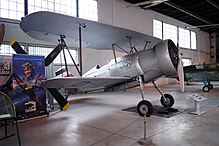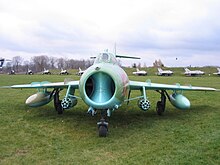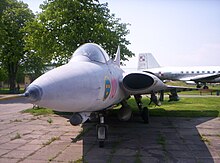Polnisches Luftfahrtmuseum
Das Polnische Luftfahrtmuseum (polnisch Muzeum Lotnictwa Polskiego w Krakowie) befindet sich auf dem ehemaligen Kraków-Rakowice-Czyżyny-Flughafen, zwischen Rakowice und Czyżyny, in Krakau. Es handelt sich um eines der weltweit größten Luftfahrtmuseen.
Geschichte
Der Flugpark 7 wurde im Jahr 1912 von Österreichern eröffnet. Das Museum wurde 1964 nach einer Flugzeugausstellung gegründet. Bis 2010 wurden die Ausstellungsstücke in vier ehemaligen Flugzeughangars ausgestellt, die für Museumszwecke nur bedingt geeignet waren. Im September 2010 erhielt das Museum einen von den Architekten Peter Ruge und Justus Pysall entworfenen zwölf Meter hohen Neubau, der auf 4.500 Quadratmetern einen Teil der Exponate fasst. Die Sammlung beinhaltet im Neubau, den acht historischen Hallen und in der Open-Air-Ausstellung über 200 Flugzeuge und etwa 100 Flugzeugmotoren, außerdem eine Luftfahrt-Bibliothek und Fotoarchive. In seinem Bestand befinden sich unter anderem schwedische, britische und US-amerikanische Militärmaschinen, aus dem Ersten Weltkrieg stammende Flugzeuge, Zivilmaschinen, Segelflugzeuge sowie seltene Exponate wie eine Etrich Taube von 1910, die Reste eines Société-Antoinette-Flugzeugs von 1908 oder die PZL P.11 aus den späten 1920er-Jahren. Darüber hinaus steht in der Haupthalle ein Denkmal für die in der Luftschlacht um England seit 1940 getöteten Polen.[1][2]
Die Bundesrepublik Deutschland fordert bis heute Ausstellungsstücke zurück, die vor allem der Deutschen Luftfahrtsammlung Berlin entstammen. Diese wurden 1943 nach Scharnikau in Pommern ausgelagert und verblieben nach Ende des Zweiten Weltkrieges in Polen.[1][3][4]
Exponate
(Quelle:[5])


Flugzeuge
- AEG Wagner Eule
- Aero Ae-145
- Aero L-29 Delfín
- Aero L-60 Brigadýr
- Albatros B.IIa
- Albatros C.I
- Albatros (DVL) H.1
- Albatros L.101
- Amiot AAC.1 Toucan (Ju 52/3m g14e)
- Antonow An-2R
- Antonow An-2TD
- Antonow An-26
- Avia B.33 (Iljuschin Il-10)
- Aviatik C.III
- Blériot XI
- Bücker Bü 131B Jungmann
- Cessna A-37B Dragonfly
- Cessna UC-78A Bobcat
- Curtiss Export Hawk II
- Dassault Mirage 5
- De Havilland DH.100 Vampire
- De Havilland DH.112 Sea Venom
- De Havilland 82A Tiger Moth II
- DFW C.V
- EM-10 Bielik (Mock-up)
- Fouga CM.170 Magister
- Friedrich Etrich Taube
- Geest Möwe IV
- Grigorowitsch M-15
- Halberstadt CL.II
- Hawker Siddeley Harrier GR.3
- Iljuschin Il-14S (VEB)
- Iljuschin Il-28R
- Iljuschin SIl-28
- Jakowlew Jak-11
- Jakowlew Jak-12
- Jakowlew Jak-17UTI (Jak-17W)
- Jakowlew Jak-18
- Jakowlew Jak-23
- Jakowlew Jak-40
- Let L-200A Morava
- Levavasseur Société Antoinette
- LFG Roland D.VIb
- Lissunow Li-2 (Douglas DC-3)
- Lockheed F-104S ASA-M Starfighter
- LVG B.II
- LWD Szpak 2
- LWD Zuch 2
- MAK-30
- Messerschmitt Bf 109G-6
- Messerschmitt Me 209 V1 (nur der Rumpf)
- Mikojan-Gurewitsch MiG-19 PM
- Mikojan-Gurewitsch MiG-21 F-13
- Mikojan-Gurewitsch MiG-21 MF
- Mikojan-Gurewitsch MiG-21 bis
- Mikojan-Gurewitsch MiG-21 PF
- Mikojan-Gurewitsch MiG-21 PFM
- Mikojan-Gurewitsch MiG-21 R
- Mikojan-Gurewitsch MiG-21 U
- Mikojan-Gurewitsch MiG-21 UM
- Mikojan-Gurewitsch MiG-21 US
- Mikojan-Gurewitsch MiG-23 MF
- Mikojan-Gurewitsch MiG-29GT
- North American T-6G Texan
- Northrop F-5E Tiger II
- Piper L-4A Grasshopper
- Polikarpow Po-2 LNB
- PWS-26
- WSK-Mielec M-15 Belphegor
- PZL I-22 Iryda M-93K
- PZL M-4 Tarpan
- PZL M-20 Mewa
- PZL P.11c
- PZL S-4 Kania 3
- PZL Szpak 4T
- PZL-101 Gawron
- PZL-104 Wilga
- PZL-105 Flaming
- PZL-106A Kruk
- PZL-130 Orlik
- RWD-13
- RWD-21
- Saab J 35J Draken
- Saab JASF37 Viggen
- SEPECAT Jaguar GR.1
- Sopwith F.1 Camel
- Stinson L-5 Sentinel
- Suchoi Su-7 BKL
- Suchoi Su-7 BM
- Suchoi Su-7 UM
- Suchoi Su-20
- Suchoi Su-22 M4
- Supermarine Spitfire LF Mk.XVIE
- Tupolew Tu-134A
- Tupolew Tu-2S
- WSK Lim-1
- WSK Lim-2
- WSK Lim-5
- WSK Lim-6bis
- WSK Lim-6M
- WSK Lim-6MR
- WSK MD-12F
- WSK SB Lim-2
- WSK SB Lim-2A
- WSK TS-9 Junak 3
- TS-11 Iskra bis B
- PZL TS-8 Bies
- WSK TS-9 Junak 3
- Zlín Z-26 Trenér
- Zlín Z-50LA
Segelflugzeuge
- IS-A Salamandra
- IS-B Komar 49
- IS-C Żuraw
- IS-1 Sęp bis
- IS-3 ABC
- IS-4 Jastrząb
- PW-2 Gapa
- Swift S-1
- SZD-6X Nietoperz
- SZD-8 bis Jaskółka
- SZD-9 bis Bocian 1A
- SZD-10 bis Czapla
- SZD-12 Mucha 100
- SZD-15 Sroka
- SZD-17X Jaskółka L
- SZD-18 Czajka
- SZD-19-2A Zefir 2A
- SZD-21 Kobuz 3
- SZD-22 Mucha Standard
- SZD-25A Lis
- SZD-27 Kormoran
- SZD-43 Orion
- WWS Wrona bis
- WWS-2 Żaba
Motorsegler
- HWL Pegaz (SP-590)
Hubschrauber
- BŻ-1 GIL
- BŻ-4 Żuk
- JK-1 Trzmiel
- Mil Mi-4 A
- Mil Mi-4 ME
- WSK Mi-2 URP
- WSK Mi-2Ch
- WSK SM-1 (Lizenz Mil Mi-1)
- WSK SM-2
Flugmotoren
- AI-14R
- AI-24WT
- Alfa Romeo 126 RC 34
- Argus As 5
- Argus As 7
- Argus As 8
- Argus As 10 C
- Argus As 410
- Armstrong Siddeley Genet
- Austro-Daimler DM 200
- Avia M-332
- Avia M-337
- Benz Bz.IVd
- BMW 132 Z
- BMW 801 D2
- BMW IIIa
- Bramo 323 Fafnir
- Breda (lic. SPA 6a)
- Bristol Cherub I
- Bristol Pegasus X
- Clerget-Blin 9B
- Daimler F 7502
- Daimler-Benz DB 600 G
- Farman 12 WE
- Farman 9 EFR
- Gnome-Rhône 9KRd Mistral
- Gnome-Rhône 9Ab Jupiter
- GTD-350
- Hirth HM 504A
- Hirth HM 508
- Hirth HM 60R
- Hispano-Suiza 12X
- Hispano-Suiza 82
- Isotta Fraschini Bianchi V 4B
- Junkers Jumo 205
- Junkers Jumo 211
- Junkers L 8
- Klimow M-103
- Klimow WK-105 PF
- Le Rhône 9
- Liberty L-12
- LIT-3 (liz. Iwtschenko AI-26)
- Lorraine-Dietrich 12 EB
- Ljulka AL-7F
- Maybach HSLU
- Maybach Mb.IV
- Mercedes D IIIa
- Mercedes D IVa
- Mercedes D IVb
- Mercedes E 4F
- Mikulin AM-34
- Mikulin AM-35A
- Mikulin M-42
- Mikulin AM-38F
- NAG C III
- Praga Doris 208B
- Pratt & Whitney Twin Wasp
- PZInż. Junior
- PZInż. Major Typ 4
- PZL Pegaz II
- PZL Pegaz VIII
- PZL WN-3
- R-11
- R-13
- R-27
- RAF 3A Napier
- RAF 4A Daimler
- RD-10A
- RD-500
- RD-9B
- Renault 12FE
- Renault 6Q11
- Rolls-Royce Eagle Mk IX
- Rolls-Royce Kestrel II S
- Rolls-Royce Merlin Mk XX
- 9D21
- R-11 (SCUD)
- Salmson 9 AD
- Salmson Z-9
- Siemens-Halske Sh 14
- Wójcicki’s ramjet engine
- Sunbeam Mohawk
- Schwezow ASch-21
- Schwezow ASch-62 IR
- Schwezow ASch-82 FN
- Schwezow M-11 D
- Schwezow M-11 FR
- Walter HWK 109-501
- Walter HWK 109-507
- Walter Minor 4-III
- Walter Mistral K-14
- Wright R-2600-23 Cyclone 14
- Wright Whirlwind R-975
- WSK Lis-2
- WSK NP-1
- WSK SO-1
Weblinks
Einzelnachweise
- ↑ a b Nikolaus Bernau: Luftfahrtmuseum Krakau Gelandet um zu bleiben, in: Frankfurter Rundschau, 20. September 2010
- ↑ BauNetz: Flügeldreieck – Luftfahrtmuseum in Krakau eingeweiht, vom 20. September 2010
- ↑ Christina Tilmann: Streit um eine Luftfahrt-Sammlung, in: Der Tagesspiegel, 21. September 2010
- ↑ FAZ vom 23. September 2010, S. 34: Auch Bauchlandungen haben ihren Sinn
- ↑ Aeroplanes. In: muzeumlotnictwa.pl. Polish Aviation Museum Cracow, abgerufen am 15. April 2019 (englisch).
Koordinaten: 50° 4′ 40″ N, 19° 59′ 26″ O
Auf dieser Seite verwendete Medien
Autor/Urheber: Varga Attila, Lizenz: CC-BY-SA-3.0
SO-1 turbojet engine, displayed at the Polish Aviation Museum, Cracow
Autor/Urheber: flyz1, Lizenz: CC BY-SA 3.0
This photo was taken during Automotive Wikiexpedition 2016 set up by Wikimedia Polska Association.
You can see all photographs in category Wikiekspedycja motoryzacyjna 2016.
Autor/Urheber: Mach240390, Lizenz: CC BY 3.0
Lotnisko Kraków-Rakowice-Czyżyny. Muzeum Lotnictwa, mały hangar. 2016
Autor/Urheber: Michał Derela (Pibwl), Lizenz: CC-BY-SA-3.0
Polish LWD Junak-3 trainer aircraft in the Polish Aviation Museum in Kraków
Autor/Urheber: Alan Wilson , Lizenz: CC BY-SA 2.0
In my opinion, early flying boats are a thing of beauty and this Russian built Grigorovich M-15 is no exception. It is the only surviving example of the 80 built and is c/n R.11C.262 It is on display in the 'WW1' hangar at the Muzeum Lotnictwa Polskiego. Krakow, Poland. 23-8-2013.
It's history is given in the following info taken from the museum website:-
"Since 1911, the Russian Imperial Navy employed French-built seaplanes (i.e. Farman, Borel and Léveque). The maintenance of the aircraft was performed at the S. S. Shchetinin & M. A. Shcherbakov Works in St. Petersburg. Since 1913 the works had been led by Dmitry Pavlovich Grigorovich. In the same year he designed, based on French originals, a successful M.1 aircraft with a boat-like fuselage. This was the beginning of a family of light flying boats, which served with distinction during the First World War.
In Autumn 1915 the Imperial Russian Navy issued an order for a heavier flying boat intended for long-range reconnaissance. In December 1915 Grigorovich built the M-9 type, which first flew on 9th January 1916. Notably, on 17th September 1916 the M-9 became the first flying boat to perform a loop, piloted by test pilot Jan Nagórski. A serious weakness of the design, however, was the licence-built Salmson-Unne radial engine. Therefore, in 1916 an improved variant designated the M-15 was built, powered by the excellent Hispano-Suiza V8 engine. Only 80 M-15 machines were built.
The Grigorovich M-15 was a long range flying boat biplane with the wing canopy placed over the fuselage, a pusher propeller and the empennage placed on a pylon, in the propeller's air stream, which increased the steering efficiency. The semi-monocoque wooden construction was covered with stressed plywood skin attached to open work formers. The wings and empennage were made of wood covered with fabric. Two stabilising floats were fitted at the ends of the lower wing.
The Grigorovich M-15 number R II C 262, built in 1917, was assigned to the fortress flight in Arensburg on the Osilia (Saaremaa) island in the fortified Moonsund archipelago, which guarded the entrance into Riga bay. These islands were captured by the Germans during land and naval campaign codenamed Operation Albion from the 10th to the 24th October 1917. The result was 20,130 POWs, 141 cannons and 10 aircraft captured among them, the R II C 262 flying boat. Tested in the Seaplanes Test Flight in Warnemünde, it eventually reached the German Aeronautical Collection in Berlin. Abandoned along with other wrecked remains of the collection in occupied Poland, found in 1945, in 1964 was moved over to the newly created Krakow's Museum as the only one, more or less complete, albeit damaged, First World War aeroplane. The restoration was undertaken by the end of the 1970s and was continued in the years 1991–1993. The aircraft is the only surviving M-15 example in the world."Autor/Urheber: Daniel Delimata, Lizenz: CC-BY-SA-3.0
Polish experimental helicopter BŻ-1 Gil in Polish Aviation Museum in Kraków
Autor/Urheber:
Saab AJSF 37 Viggen (37954) at Muzeum Lotnictwa Polskiego in Krakow, Poland.
Autor/Urheber: Alan Wilson , Lizenz: CC BY-SA 2.0
This RWD 13 (c/n 283) previously saw Romanian Air Force service with the serial '6'. It is now on display in the new entrance building at the Muzeum Lotnictwa Polskiego. Krakow, Poland. 23-8-2013.
The following info is taken from the museum's website:-
"RWD - Stanisław Rogalski, Stanisław Wigura and Jerzy Drzewiecki - the three young engineers, who at the beginning of the 1930's, designed the whole family of the excellent sport aircraft. With the RWD 5bis, f/lt Stanisław Skarżyński crossed the Atlantic in 1933, with the RWD 6, f/lt Franciszek Żwirko and Stanisław Wigura, won the 1932 Challenge International des Avions de Torisme and in 1934, f/lt Jerzy Bajan and f/sgt Gustaw Pokrzywka repeated this success, in the RWD 9. In the fall of 1934, as a commission of the Air and Gas Defence League (LOPP), engineers Stanisław Rogalski, Leszek Dulęba and Jerzy Drzewiecki worked on a popular tourist aircraft. Initially, it was planned to carry the RWD 6 bis designation - the three seat RWD 13 was the developed version of the RWD 6 and the RWD 9. Despite resigning from the complex and expensive technology, the aircraft possessed very good flight and STOL characteristics. On a welded truss, the body of wooden longerons and fabric covered formers was imposed to achieve better aerodynamic shape. The whole fuselage was fabric covered and the wings were of plywood with a fabric covering. The cockpit, with good visibility, was equipped with heating and ventilation. Long travel shock absorbers allowed for hard landings. The folding wings (for better storage), were equipped with automatic slots and slotted ailerons. The aircraft was powered by an inverted in - line engine. The first SP - AOA RWD 13 prototype took to the air, on the 15th January 1935, flown by Kazimierz Chorzewski. After introducing a few minor changes into the airframe construction, serial production of the RWD 13 started in May 1935. It was continued until the outbreak of war in 1939. 20 aircraft out of 100 produced were exported. One of the RWD 13 still flies in Brasil. In Poland, the majority of the RWD 13 aircraft were bought by the Ministry of Communication and by LOPP. A few reached private hands and two or three aircraft were bought by military authorities in August 1939. During the flight in September to the base in Brześć, where they had to serve as executive machines, one was shot at mistakenly, by Polish anti aircraft artillery. The aircraft was also licence produced by the Yugoslavian Rogozarski Works. In September 1939, some 30 RWD 13 and 13 S were interned in Romania and one in Sweden. Since 1937, in parallel to the RWD 13, the ambulance version RWD 13 S was produced. During the International Sanitary Aviation Competition in July 1938, in Luxemburg, the RWD 13 S was voted as the best machine. Apart from this, the RWD 13 took part in national and international air shows: International Jamboree in Holland, the 4th International Air Meeting in Zurich and the Air Meeting at the Balaton Lake, Hungary. In May 1939, the luxury version SP - BNY RWD 13 was presented as a wedding gift by the President of the Republic of Poland to the Persian crown prince Mohammed Reza.
The RWD 13 served as an ambulance and liaison aircraft during the Spanish Civil War, the Polish Campaign, on the Eastern Front by the Romanians (against Soviets) and by Jews in 1947 against the Arabs. In the same year, four of the RWD 13's interned in Romania had returned to Poland The exhibited aircraft served in aeroclubs until 1935. In 1963 it was given to the Museum."PWS-26
Autor/Urheber: Varga Attila, Lizenz: CC BY-SA 3.0
Lyulka AL-7F1 turbojet engine, displayed at the Polish Aviation Museum, Cracow
Autor/Urheber: Daniel Delimata, Lizenz: CC-BY-SA-3.0
Polish utility aircraft LWD Szpak-4T, markings SP-AAG, Polish Aviation Museum in Kraków
(c) mamik / fotopolska.eu, CC BY-SA 3.0
Główny budynek Muzeum oddany do użytku dzień przed zrobieniem zdjęcia
Autor/Urheber: Michał Derela user:Pibwl, Lizenz: CC-BY-SA-3.0
PZL-Mielec M-4 Tarpan - Polish trainer aircraft prototype, Polish Aviation Museum in Kraków
Autor/Urheber: Mach240390, Lizenz: CC BY 3.0
Lotnisko Kraków-Rakowice-Czyżyny. Muzeum Lotnictwa - duży hangar. 2016
Autor/Urheber: Varga Attila, Lizenz: CC-BY-SA-3.0
WSK-Mielec M-15 Belphegor Polish jet agricultural aircraft, displayed at the Museum of Polish Aviation, Cracow
Autor/Urheber: Delimata, Lizenz: CC-BY-SA-3.0
De Havilland 82A Tiger Moth II in Polish Aviation Museum
Autor/Urheber:
Saab J 35J Draken at Polish Aviation Museum in Krakow, Poland
Autor/Urheber: Daniel Delimata, Lizenz: CC-BY-SA-3.0
TS-11 Iskra in Polish Aviation Museum in Kraków







































